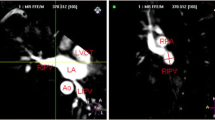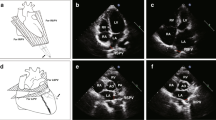Abstract
Magnetic resonance angiography (MRA) is a safe and non-invasive imaging method that can readily depict the pulmonary veins (PV), whose imaging has acquired momentum with the advent of new techniques for radiofrequency ablation of atrial fibrillation (AF). We evaluated whether virtual endoscopy from 3D MRA images (MRA-VE) is feasible in studying the morphology of PV. Fifty patients with AF underwent pre-ablative MRA (1.5 T). Images were acquired with axial T-2 weighted and 3D-SPGR sequences after intravenous administration of Gd-DTPA and automatic triggering. Postprocessing was performed by an experienced radiologist with maximum intensity projection (MIP) and virtual endoscopy software (Navigator, GEMS). The venoatrial junction was visualized with MRA-VE in 49 of 50 patients (98.0%). Twenty-seven patients (55.1%) had two ostia on both sides, 13 patients (26.5%) had two ostia on the right and a single common ostium on the left, 5 patients (10.2%) had accessory PV and 4 patients (8.2%) had both an accessory right PV and a single common ostium on the left. Flythrough navigation showed the number and spatial disposition of second-order PV branches in 48 out of 49 patients (98.0%). MRA-VE is an excellent tool for at-a-glance visualization of ostia morphology, navigation of second-generation PV branches and easy endoluminal assessment of left atrial structures in pre-ablative imaging.





Similar content being viewed by others
References
Godart F, Cocheteux B, Willoteaux S et al (2002) Importance of magnetic resonance angiography with gadolinium injection in pulmonary vein diseases. Arch Mal Coeur Vaiss 95:433–437
Wood MA, Wittkamp M, Henry D et al (2004) A comparison of pulmonary vein ostial anatomy by computerized tomography, echocardiography, and venography in patients with atrial fibrillation having radiofrequency catheter ablation. Am J Cardiol 93:49–53
Lacomis JM, Wigginton W, Fuhrman C, Schwartzman D, Armfield DR, Pealer KM (2003) Multi-detector row CT of the left atrium and pulmonary veins before radio-frequency catheter ablation for atrial fibrillation. Radiographics 23(Spec No):S35–S48 (discussion S48–S50)
Maksimovic R, Cademartiri F, Scholten M, Jordaens LJ, Pattynama PM (2004) Sixteen-row multislice computed tomography in the assessment of pulmonary veins prior to ablative treatment: validation vs. conventional pulmonary venography and study of reproducibility. Eur Radiol 14:369–374
Prince MR (1996) Body MR angiography with gadolinium contrast agents. Magn Reson Imaging Clin N Am 4:11–24
Ernst S, Broemel T, Krumsdorf U et al (2003) Three-dimensional reconstruction of pulmonary veins and left atrium. Implications for catheter ablation of atrial fibrillation. Herz 28:559–565
Pilleul F, Merchant N (2000) MRI of the pulmonary veins: comparison between 3D MR angiography and T1-weighted spin echo. J Comput Assist Tomogr 24:683–687
Hoffmann U, Schima W, Herold C (1999) Pulmonary magnetic resonance angiography. Eur Radiol 9:1745–1754
Dill T, Neumann T, Ekinci O et al (2003) Pulmonary vein diameter reduction after radiofrequency catheter ablation for paroxysmal atrial fibrillation evaluated by contrast-enhanced three-dimensional magnetic resonance imaging. Circulation 107:845–850
Wittkampf FH, Vonken EJ, Derksen R et al (2003) Pulmonary vein ostium geometry: analysis by magnetic resonance angiography. Circulation 107:21–23
Collins JD, Pereles FS, Bello D, Betts T, Song GK, Finn JP (2002) Pre-ablative pulmonary venous mapping by high-resolution MRA angiography facilitates electrophysiologic pulmonary vein ablation and reduces fluoroscopy time in patients with paroxysmal atrial fibrillation. RSNA Scientific Sessions, Chicago, p 473
Kato R, Lickfett L, Meininger G et al (2003) Pulmonary vein anatomy in patients undergoing catheter ablation of atrial fibrillation: lessons learned by use of magnetic resonance imaging. Circulation 107:2004–2010
Yazar F, Ozdogmus O, Tuccar E, Bayramoglu A, Ozan H (2002) Drainage patterns of middle lobe vein of right lung: an anatomical study. Eur J Cardiothorac Surg 22:717–720
Buthiau D, Antoine E, Piette JC, Nizri D, Baldeyrou P, Khayat D (1996) Virtual tracheo-bronchial endoscopy: educational and diagnostic value. Surg Radiol Anat 18:125–131
Wood BJ, Razavi P (2002) Virtual endoscopy: a promising new technology. Am Fam Physician 66:107–112
World Medical Association Declaration of Helsinki (1964) Ethical principles for medical research involving human subjects. World Medical Association, Helsinki
Foo TK, Saranathan M, Prince MR, Chenevert TL (1997) Automated detection of bolus arrival and initiation of data acquisition in fast, three-dimensional, gadolinium-enhanced MR angiography. Radiology 203:275–280
Davis CP, Ladd ME, Romanowski BJ, Wildermuth S, Knoplioch JF, Debatin JF (1996) Human aorta: preliminary results with virtual endoscopy based on three-dimensional MR imaging data sets. Radiology 199:37–40
Ladd ME, Gohde SC, Steiner P, Pfammatter T, McKinnon GC, Debatin JF (1996) Virtual MR angioscopy of the pulmonary artery tree. J Comput Assist Tomogr 20:782–785
Picard JD, Buthiau D (1999) Virtual endoscopy. Bull Acad Natl Med 183:465–475 (discussion 466–475)
Fenlon HM, Nunes DP, Schroy PC III, Barish MA, Clarke PD, Ferrucci JT (1999) A comparison of virtual and conventional colonoscopy for the detection of colorectal polyps. N Engl J Med 341:1496–1503
Neri E, Caramella D, Bisogni C et al (1999) Detection of accessory renal arteries with virtual vascular endoscopy of the aorta. Cardiovasc Intervent Radiol 22:1–6
Lickfett L, Kato R, Berger R, Halperin H, Calkins H (2002) Magnetic resonance angiography and virtual endoscopic view of a left common pulmonary vein trunk. J Cardiovasc Electrophysiol 13:955
Davis CP, Hany TF, Wildermuth S, Schmidt M, Debatin JF (1997) Postprocessing techniques for gadolinium-enhanced three-dimensional MR angiography. Radiographics 17:1061–1077
Moubarak JB, Rozwadowski JV, Strzalka CT et al (2000) Pulmonary veins—left atrial junction: anatomic and histological study. Pacing Clin Electrophysiol 23:1836–1838
Weiss C, Gocht A, Willems S, Hoffmann M, Risius T, Meinertz T (2002) Impact of the distribution and structure of myocardium in the pulmonary veins for radiofrequency ablation of atrial fibrillation. Pacing Clin Electrophysiol 25:1352–1356
Ho SY, Sanchez-Quintana D, Cabrera JA, Anderson RH (1999) Anatomy of the left atrium: implications for radiofrequency ablation of atrial fibrillation. J Cardiovasc Electrophysiol 10:1525–1533
Moak JP, Moore HJ, Lee SW et al (2000) Case report: pulmonary vein stenosis following RF ablation of paroxysmal atrial fibrillation: successful treatment with balloon dilation. J Interv Card Electrophysiol 4:621–631
1990 Recommendations of the International Commission on Radiological Protection (1991) ICRP Publication 60. Annals of ICRP 21
Author information
Authors and Affiliations
Corresponding author
Rights and permissions
About this article
Cite this article
Cirillo, S., Bonamini, R., Gaita, F. et al. Magnetic resonance angiography virtual endoscopy in the assessment of pulmonary veins before radiofrequency ablation procedures for atrial fibrillation. Eur Radiol 14, 2053–2060 (2004). https://doi.org/10.1007/s00330-004-2406-1
Received:
Revised:
Accepted:
Published:
Issue Date:
DOI: https://doi.org/10.1007/s00330-004-2406-1




